By Anthony Pozun, RN
Photos by the author
Over the summer of 2019, I decided to travel from my home in Northport, NY south to Florida and the Bahamas on my Catalina 400 Mark II Mystical Paradise. She’s rigged for long term cruising, with two headsails including her 150% genoa and a small cutter-type staysail for light air sailing, as well as a full cockpit enclosure. I stocked her with enough foodstuffs and water for six months of liveaboard cruising.
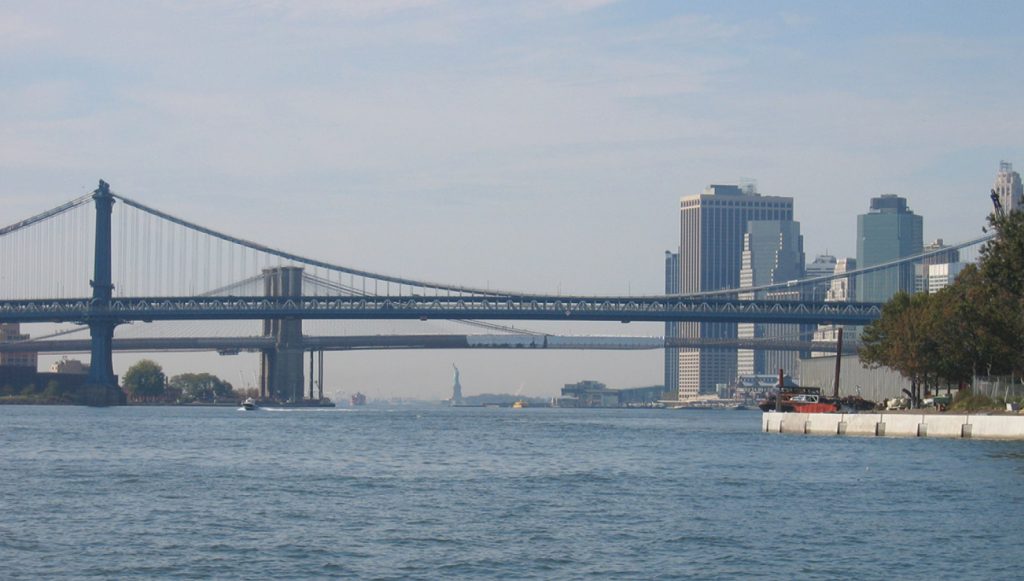
The East River Bridges, with the Statue of Liberty
This would be my eleventh and final trip south, as I wanted to spend more time with my wife and grandson over the winters. This trip would be different because I would not be traveling alone. I prefer solo travel, but my wife insisted I travel with someone. My friend Randy Owens was also planning on going south on his Island Packet 38 to spend the winter in Florida. We spoke and it was agreed we would travel together, each on our own boat.
After Hurricane Dorian devastated the Bahamas in September, I decided this trip would be one of humanitarian relief. Over the summer, friends, family, and associates on Facebook had donated close to $2,000 for medical supplies, clothing, tools, etc. that I intended to donate to the people of Freeport, Grand Bahama. I purchased on eBay and from many medical supply houses on Long Island at discounted prices (or donated) some $3,000 of supplies. I requested from the Louis Accampora Foundation of Northport the donation of two Automated External Defibrillators (AEDs) to be given to the Bahamas National Trust’s Exuma Cays Land & Sea Park. Additionally, I received hundreds of donations of new clothing from members of Northport Yacht Club and the Neptune and Captree U.S. Power Squadrons, as well as 500 brand new t-shirts of all colors and sizes from the Make-A-Wish Foundation of Metro New York.
As an American Heart Association Basic Life Support instructor, I have taught many personnel in the Exuma Cays Land & Sea Park over the past few years. Until recently, the Bahamas had no Coast Guard-type service to assist the many boaters visiting from all over the world. After many requests from thousands of boaters and citizens alike, the Bahamian government expanded their Defense Force from drug interdiction task force into a complete marine service-oriented unit. Many of the Defense Force personnel in the Exumas do not have First Aid and CPR training. On this trip, I would certify park personnel and Defense Force personnel in First Aid, CPR, and AED usage and donate the AEDs to the park. With luck, I would also sneak in a few scuba dives in the most beautiful waters in this part of the world.
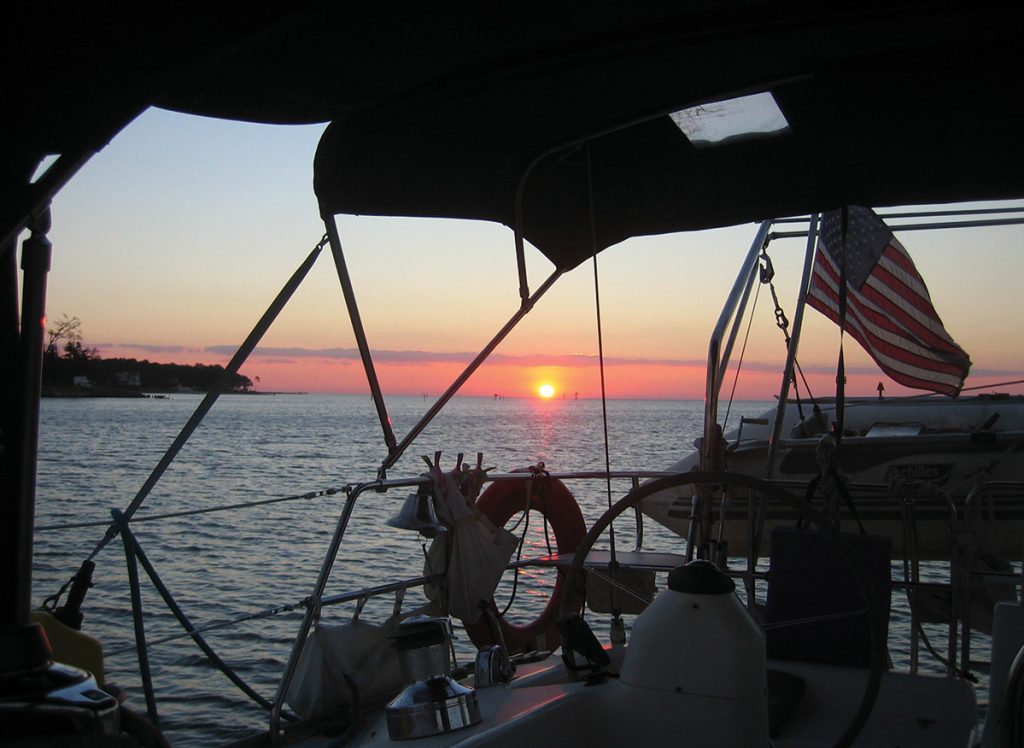
Sandy Hook sunrise
With my sailboat packed to the gills with my own food and supplies, scuba gear, medical supplies and clothing, Randy on Shore Loser and I on Mystical Paradise departed from Northport October 27, 2019. As this was Randy’s first trip on the ocean and the Intracoastal Waterway, I took the lead out of New York Harbor. We motorsailed the East River and made anchorage the first night in Sandy Hook, NJ. I was happy the trip started out without incident. We sailed closely together for three days on the ocean and reached Atlantic City October 30.
We found a nice spot in Brigantine Bay, off the channel in five feet of water behind a small island. That night, the first of four incidents, breakdowns and issues befell me and my mission. Randy and I were anchored side by side, and at 10 pm as I was preparing for bed we were hit by a drunken boater. He hit us so hard it knocked me down, separated all three lines holding Randy and I together, and spun Mystical Paradise around like a toy.
The drunk had no ID and no papers and was trying to leave. In my best authoritative voice, I demanded he stay and wait for authorities. The Coast Guard arrived within minutes and held the man for the New Jersey State Police, who unfortunately did not arrive until 4 am. By that time, the man had sobered up and was not arrested. Little did I know that as the boat spun, my driveshaft strut hit something underwater. That started a series of continual breakdowns including a misaligned driveshaft, transmission failure, missing keyways and a blown out sail…all of which would extend my trip until April 2020.
In a few days, Randy and I continued our ocean sail to Norfolk, Virginia, from which we would take the Intracoastal Waterway (ICW) south. As this was Randy’s first trip on the ICW, I let him take the lead. As we approached Naval Station Norfolk, Randy’s voice via the VHF really showed his excitement. Soon my excitement also grew, as I knew we were approaching Mile Zero of the ICW. The start of the ICW is designated by a simple all yellow buoy, placed off the channel in about ten feet of water. This is Mile Marker 00, designated “MM00.” From here onward, there’s a small yellow triangle or square on each ICW day marker, pole, or buoy, always on the same side when going south or north. Going south, there’s a triangle for starboard (right) side of channel, and a square for the port side. Also, the entire ICW to Florida has mile markers to designate where you are, as well as designating anchorages, bridges, towns, parks, other unique features, etc.
The yellow buoy indicating MM00 was almost obscured by dozens of boats anchored there. If I hadn’t known the marker is directly in front of the stately brick Naval Hospital, I might have missed it altogether. The marker is exceedingly small and somewhat non-descript. On my first trip eleven years before, seeing the marker for the first time meant the world to me. I had dreamed and researched this journey for years, and had finally traveled and made Mecca. I was a little disappointed by the marker’s size, but nonetheless ecstatic.
We were now officially on the ICW and on our way. We anchored for the night and contemplated what lay ahead: only 1,090 miles to Miami. The official name of the ICW is Atlantic/Intracoastal Waterway (AICW). For true purists, “The Ditch” officially starts in Norfolk at the Portsmouth Naval Hospital on the Elizabeth River, and continues to Key West. To many boaters, it starts in Maine and goes south along the Eastern Seaboard.
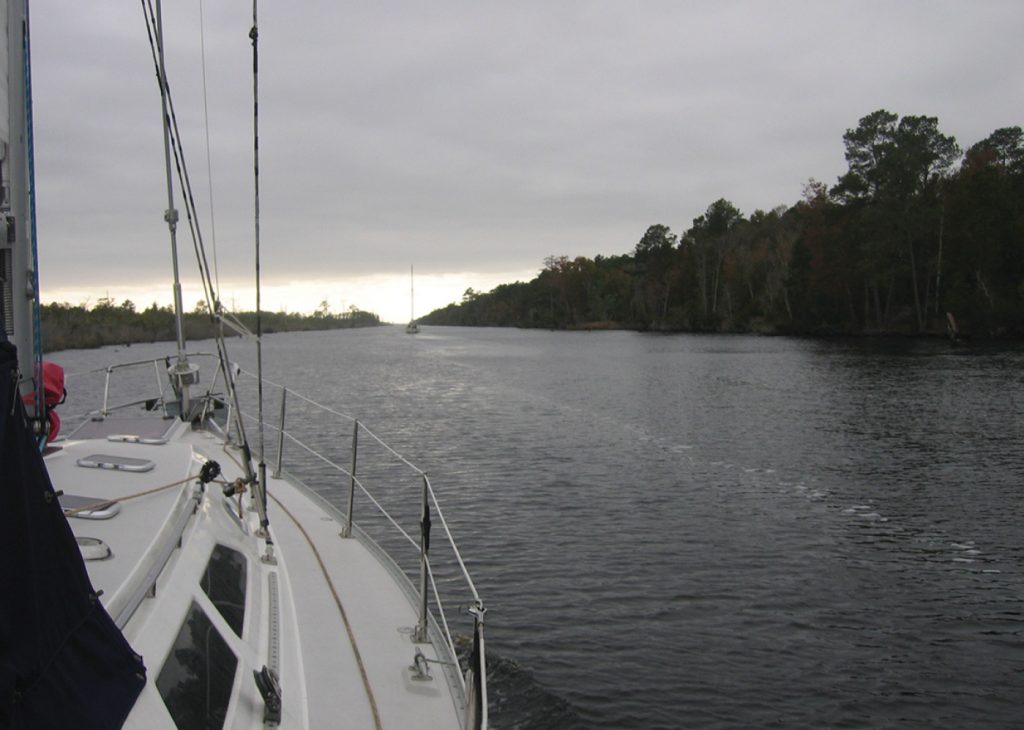
Shore Loser leads the way on the ICW.
Additionally, the AICW is part of America’s Great Loop, which runs south on the Hudson River from Albany New York to New Jersey, then Norfolk. From Norfolk it runs inland to Florida, across that state into the Gulf of Mexico, westward to the Mississippi River, and northward to the Great Lakes. It then travels across the U.S. eastward through the Erie Canal or St. Lawrence Seaway to Albany. Many cruisers take this route every year as a journey across a beautiful part of inland America.
The Great Loop is longer than the Nile, safer than one can possibly imagine in advance, and absolutely amazing. Combined with our nation’s Inland River System, it plays a vital role in linking the Gulf of Mexico and Atlantic Ocean. The Loop offers the opportunity to explore over 29,400 miles of inland rivers in America’s heartland. Cruisers completing the Loop have boated the same official qualifying distance of sailors circumnavigating the globe! The Loop passes mountains and marshlands, lush vineyards, antebellum mansions, farmlands, century old towns, castles, cathedrals, Giant Cypress trees, and Civil War battlefields. This amazing beauty has inspired countless writers, musicians, novelists, poets, photographers, and yes, thousands of Loopers.
The next morning, we hauled anchor and starting motoring south, with Randy leading the way. For the next two days we enjoyed all the sights and sounds of the beautiful ICW. One hundred miles later on November 7, as we turned into the quaint town of Bell Haven, North Carolina, I felt a strange shudder. I lost propulsion, and I threw out my anchor. I called Randy, who came alongside and tied Shore Loser to me. Upon inspection, my driveshaft appeared to be turning but I was going nowhere. I called SeaTow advised them of my situation. They had no boat within 100 miles but said they’d call TowBoatUS.
The TowBoatUS captain towed me to a boatyard a short distance away. Upon arriving, I cringed when I saw their haulout crane. The lifting straps were worn, cables rusted, and the crew did not seem to know what to do. I asked to be towed to SailCraft Service in Oriental (50 miles away), but the captain said he couldn’t do that.
I held my breath as Mystical Paradise was pulled from the water, hanging haphazardly in the straps and almost falling to the ground. The boat was found to have a broken driveshaft. I asked the owners of the yard if they could repair it and get me on my way by December, and they assured me they could. I had to pay up front before any parts were ordered or work started.
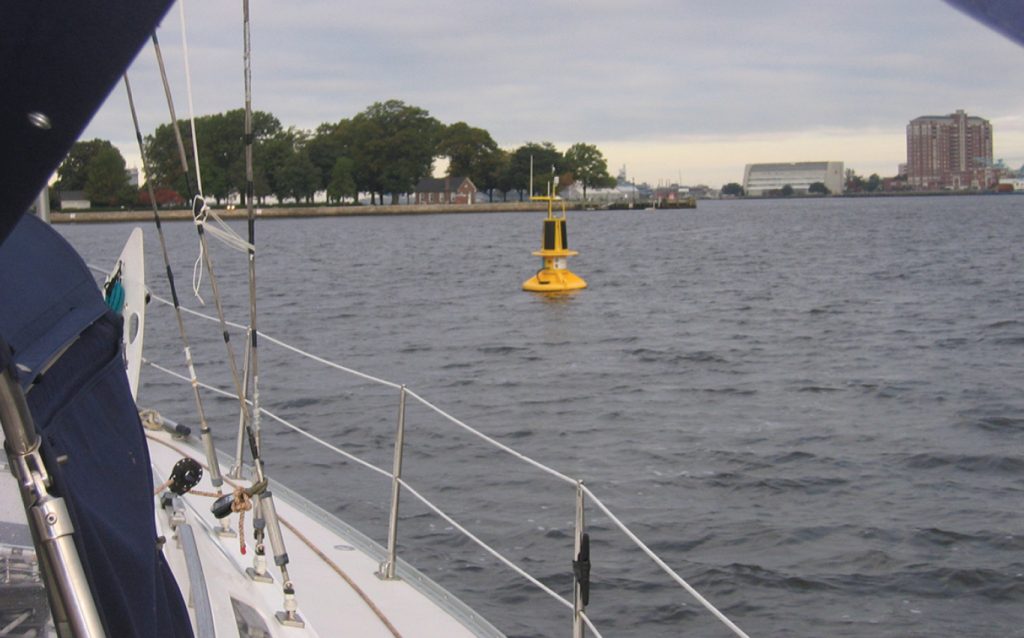
One of many mile markers along the ICW
I was able to stay on the boat every day, and made the best of the situation by painting the bottom. The two owners then disappeared for three weeks. Although the parts came in right away and yard workers were there every day, they couldn’t work on my boat without the owners’ OK. Feeling like I was being held hostage, I took matters into my own hands and started removing the prop and driveshaft the day after Thanksgiving. Then the owners reappeared. Workers finally started removing the damaged running gear, but it was another two months before the job was finished. Their shoddy work would cause additional breakdowns. Additionally, as the yard had no fiberglass repairman, I had to go elsewhere to have those repairs done.
On January 16, I sailed south to Oriental to have the fiberglass damaged during the collision repaired. Stopping at SailCraft Service, I hired an outside contractor, my friend Ken “Turtle” Midyette. Turtle made all necessary fiberglass repairs while I visited the town. On January 29, I motorsailed to Beaufort (pronounced Boofort) North Carolina and entered the Atlantic Ocean en route to Charleston.
After enjoying a beam wind most of the day, at 2 am the winds increased to 35 to 40 mph from astern. I reefed down to sail comfortably. By 6 am the winds had increased to 50 mph as I continued to reduce sail. For the next two days, I encountered winds up to 60 mph and waves to six feet, while surfing at 10 mph towards Charleston. On the third day I entered Charleston Harbor wet, tired and bedraggled. I anchored, hit the sack and was out cold in five minutes.
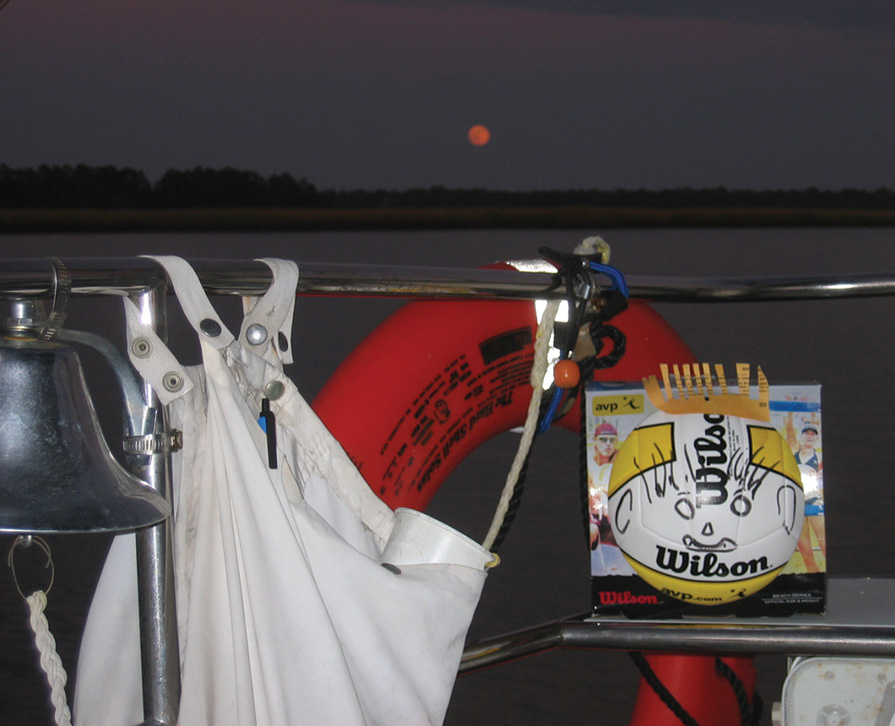
Tony’s shipmate Wilson isn’t much of a deckhand, but he doesn’t drink and mostly keeps his mouth shut.
Awakening next day, the weather channel reported gale force winds of 60-plus and waves to 10 feet on the ocean. I decided to stay inside on the ICW for safety and not getting beat up again. Good thing, for as I raised the mainsail to motorsail, I discovered a broken gooseneck. It was made of stamped aluminum, which I’d assessed years before as a weak design. As I had always sailed Mystical Paradise hard for sixteen years, this break was almost expected. I pulled into a marina and contacted another friend, a rigger, who installed a custom-made stainless steel gooseneck that I expect will last at least sixteen years.
Motorsailing for the next few days, I wound my way on the wandering ICW. Through parts of South Carolina and most of Georgia the waterway is made from many small rivers and streams. At times, I found myself motoring west, east or north to go south. It was worth it, as the sights and sounds of nature on the ICW on a slow-moving boat are beautiful to experience. The waterway here winds its way through South Carolina’s cypress swamps and other low-lying areas. Passing through “the Low Country,” the peculiar swamp smell was odiferous, like decaying, slippery mud at low tide. Providing rich soil for the area’s once plentiful plantations, the pluff mud (as it’s called) remains a source for vegetation growth, but its smells terribly strong and strange.
I continued motorsailing until I reached Beaufort (pronounced Beoofort), South Carolina. Anchoring for the night, I sailed out St. Simons Sound in the morning. Reaching open water, I turned south and enjoyed a beam wind and sea for the next two days. I always use the ocean, even without wind, as the ICW in southern South Carolina and Georgia, though quite beautiful, is treacherously shallow and winding. I enjoyed immensely my two-day beam reach all the way to Jacksonville, Florida. I anchored inside near Sisters Creek just off the St. Johns River and recovered from my 48-hour sail.
Next morning the wind and ocean gods smiled on me again, providing another beam wind that allowed me to reach all the way to St. Augustine. Enjoying the warm Florida sunshine on my face, I dropped anchor directly in front of Castillo de San Marcos, the oldest masonry fort in America. With no other boats nearby, I felt I’d gone back in time and was a famous European explorer.
Castillo de San Marcos was designed by the Spanish engineer Ignacio Daza. Construction began in 1672, 107 years after the founding of St. Augustine. Its construction was ordered by the Governor of St. Augustine after a destructive raid by the English privateer Robert Searles in 1668. The first coquina stones were laid in 1672. The construction of the core of the current fortress was completed in 1695, though it would undergo many alterations and renovations over the centuries.
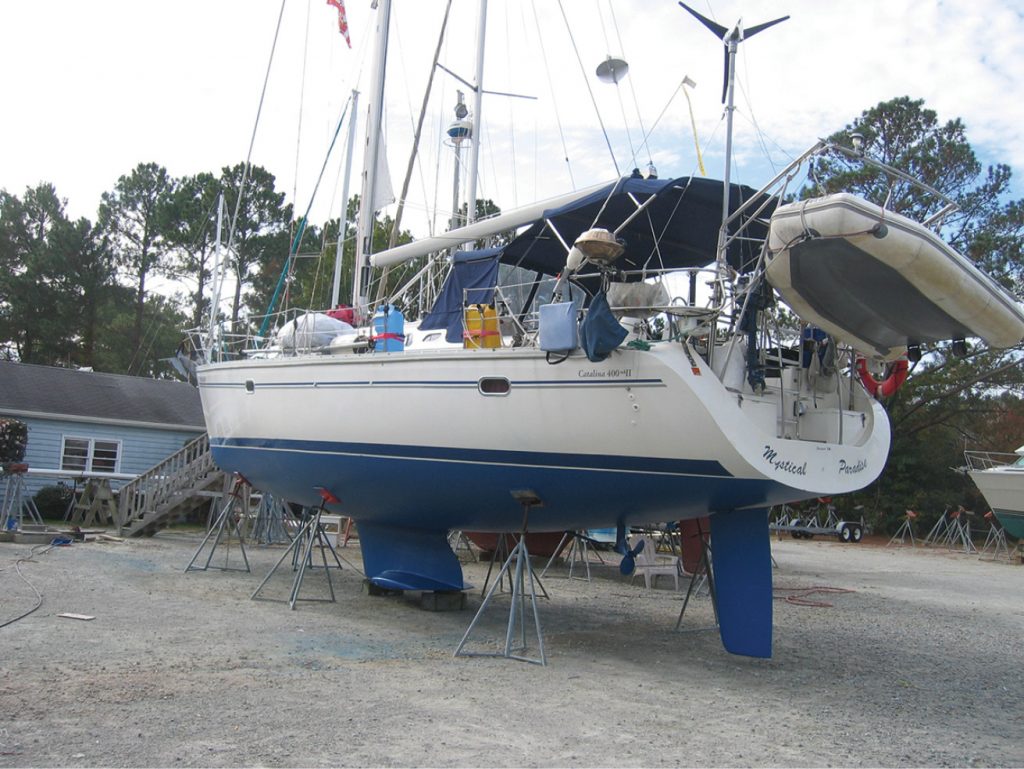
An unexpected and lengthy layover in North Carolina was an opportunity to give Mystical Paradise a fresh coat of bottom
When Britain gained control of Florida in 1763 pursuant to the Treaty of Paris, St. Augustine became the capital of British East Florida and the fort was renamed Fort St. Mark until the Peace of Paris when Florida was transferred back to Spain and the fort’s original name restored. In 1819, Spain signed the Adams-Onís Treaty that ceded Florida to the United States in 1821. Consequently, the fort was designated a U.S. Army property and renamed Fort Marion, in honor of American revolutionary war hero Francis Marion. The fort was declared a National Monument 1924, and after 251 years of continuous military possession, was deactivated in 1933. The site was subsequently turned over to the U.S. Parks Service. In 1942 the original name, Castillo de San Marcos, was restored.
Under United States control, the fort was used as a military prison to incarcerate Native Americans tribes starting with the Seminole and members of western tribes. The American art form known as Ledger art had its origins at the fort during the imprisonment of members of the plain’s tribes, including the southern Cheyenne.
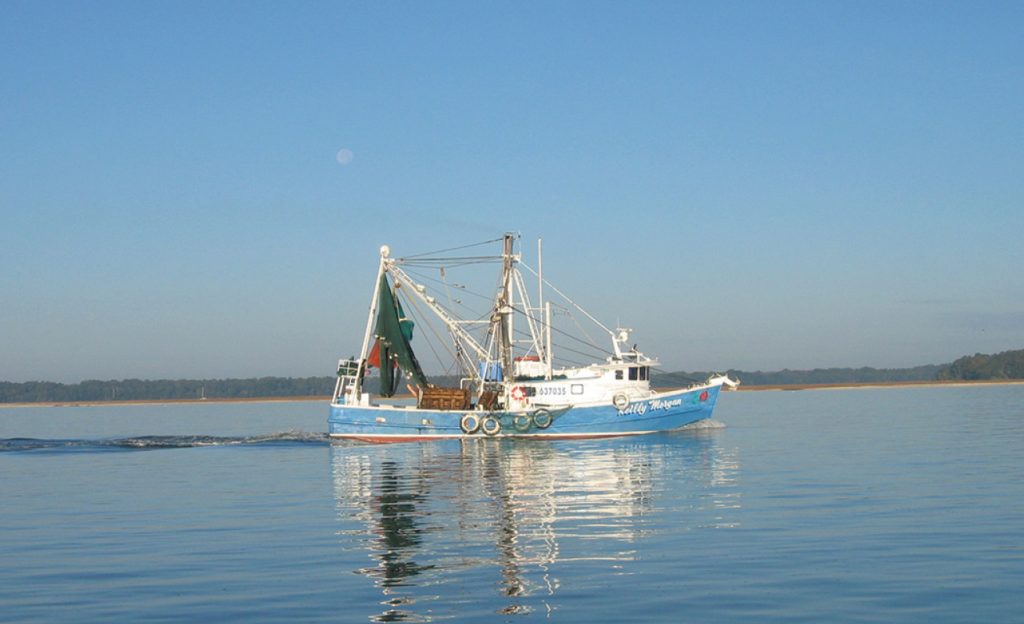
A quiet morning in South Carolina’s Low Country
Next morning the weather gods were giving the ocean a hard time. NOAA weather was calling for southerly winds at 30-40 mph and seas from six to eight feet. As motorsailing into 8-foot waves would be dangerous, I decided to stay inside. Passing under the famous Bridge of Lions bascule bridge, I was appalled by the sight before me – something I saw happening with alarming regularity in Florida. Because of year-round warm weather, many people take up residence on any manner or condition of boats, or barges. It’s a way they can live for free on the water, usually unmolested. Their garbage and waste are deposited in the pristine waters without treatment. Some abandon the boats to the mercy of the elements. They become an eyesore, continue to pollute, and become derelict and a danger to all other boaters. Municipalities have spent millions removing these “voodoo-boats” along the ICW, but they continue to be a problem. Many towns have passed laws against anchoring for extended periods. As a misdirected backlash, the laws also prohibit cruisers from anchoring at a place for any length of time.
Continuing south, I passed beautiful undeveloped areas, then areas of massive urbanization. Motorsailing to MM 829 in the Daytona Beach area, the next populated place, I continued to be fascinated by the beautiful scenery both natural and manmade. I was both mesmerized and frustrated: mesmerized by the high-rise buildings and magnificent homes along the ICW, and frustrated by continuing issues with bridges, and now the high volume of boat traffic.
With boats going north, south and in other directions, it became a challenge to get through this area without a collision. Many of these local boats do not display the courtesy shown by cruisers on the ICW.
Florida has more bridges crossing the ICW than any other state. In Daytona Beach alone, I passed eight bridges, five being request or timed opening. These are relatively new, standing next to other modern, high-rise bridges. Having a human operated swing or bascule bridge next to a high-rise bridge makes no sense at all, but it’s a frustrating fact of life in all of the four states I transited. So, what should have taken twenty minutes to pass this section took over two hours. The time spent avoiding inconsiderate boaters and bridge operators was downright frustrating.
Vowing to take the ocean as soon as I was able, I exited the ICW at Ponce Inlet a few miles south. To my astonishment, the ocean had calmed down and I enjoyed an easterly beam wind and reach. I sailed in this fashion for the next 100 miles to the St. Lucie Inlet, where I pulled in and anchored at Manatee Pocket in Stuart and enjoyed a beautiful sunset. Believing my problems were over, that night I rechecked all my charts and planned my crossing to the Bahamas.
Hauling anchor next morning, I started motor sailing towards the inlet. As I crossed the ICW, I felt a bad vibration and clattering coming from the engine area. I immediately turned around, intent on anchoring in Manatee Pocket to check the problem. As I continued, I felt the transmission go in and out of gear several times. I knew I had a major problem, so I called Hinckley Yachts, which I knew is a repair boatyard and Yanmar dealer. I asked if they could check out or haul out my boat. They replied in the affirmative and I proceeded to their haulout basin.
Approaching the basin, I noticed two 80-foot yachts on each side. I sweated with the thought of losing all drive and slamming into one of them. Just then, about 100 yards from the basin I did lose all propulsion. Luckily, a small breeze came up from astern and I gently guided the boat into the basin as if I’d planned to do that. Hinckley hauled the boat and inspection revealed a blown transmission. Mystical Paradise needed to stay out of the water for repairs, so they moved and blocked her. That afternoon, I sat with service people and was advised there were no Yanmar transmissions available for anything from three weeks to three months. Frustrated, I agreed to have them keep the boat and make repairs. In a few days, I flew home to my family and contemplated the problems of my trip.
To be continued… ■
An avid boater, sailor and scuba diver for over half a century, Anthony Pozun, RN is a sailing instructor and co-chair of the Training Committee at the Northport Yacht Club, an executive officer and senior instructor with the Neptune Sail & Power Squadron, a certified NAUI diver and assistant instructor, a Senior CPR and First Aid instructor with the American Heart Association, and an active New York State Registered Nurse. He’s completed ten solo trips from Long Island to the Bahamas and back aboard Mystical Paradise. Look for a review of Tony’s first book about his journeys, Doing The Ditch, in an upcoming issue of WindCheck.




